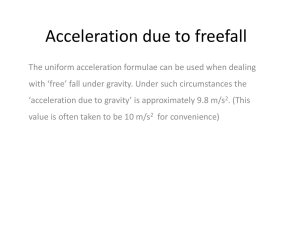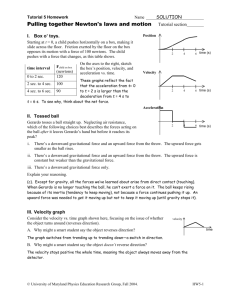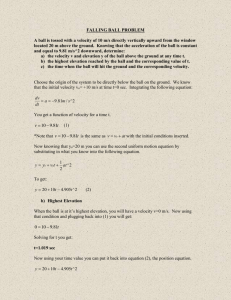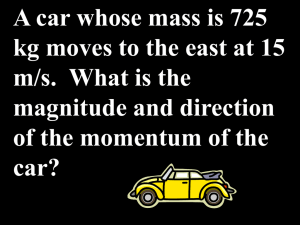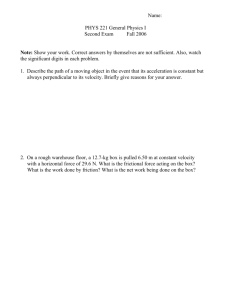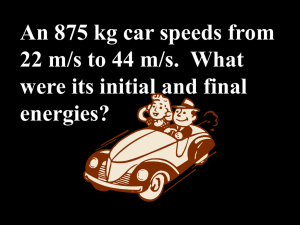PHYSICS Lecture 3 Free Fall
advertisement
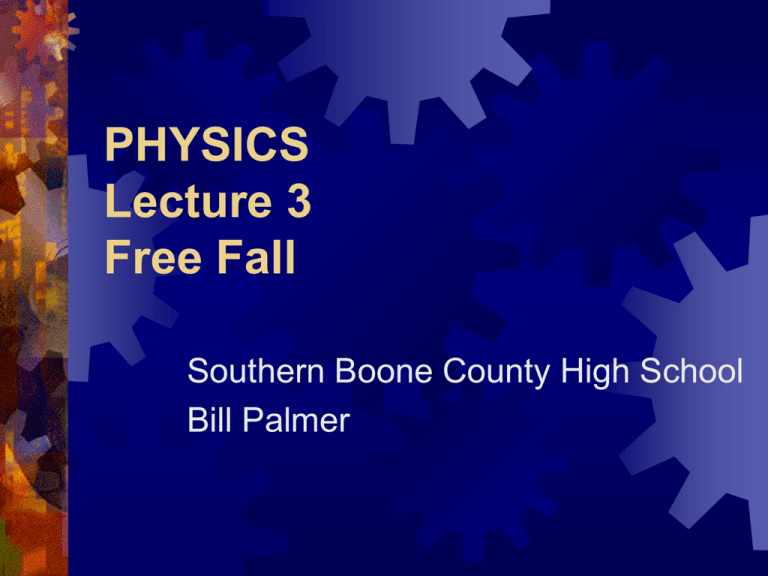
PHYSICS Lecture 3 Free Fall Southern Boone County High School Bill Palmer Physics-Free Fall All freely falling objects fall at the same rate-Galileo 1600s Neglecting the effects of air True in air or water Galileo “Diluted” gravity by rolling things down ramps (sound familiar?) Leaning Tower of Pisa Physics-Free Fall g=Acceleration due to gravity Slight differences at various spots on earth due to due to uneven distribution of mass over earth’s surface Think of g over a iron mine vs. g over ocean g=9.80 m/s2 For each second an object falls the downward velocity increases by 9.80 m/s Physics-Free Fall What if a ball is thrown up? The ball slows down so a is negative. a= -g = -9.80 m/s2 Physics-Free Fall Throw a ball upward with a velocity of 20 m/s. Gravity slows the velocity at a rate of 9.80 m/s So, after 1 sec the ball has slowed from 20 m/s – 9.80 m/s = 10.2 m/s After 2 sec the ball has slowed another 9.80 m/s or 10.2 m/s – 9.8 m/s = .4 m/s Physics-Free Fall What happens after three seconds? .4 m/s – 9.80 m/s = - 9.4 m/s Now the ball is going down At 4 seconds the ball is moving down at –9.4 m/s plus another 9.80 m/s = 19.2 m/s At about 2 sec, the balls velocity is 0 Physics-Free Fall The Demon Drop is a ride at an amusement park where a car falls freely for 1.5 sec after starting from rest. What is its velocity at the end of 1.5 s? How far did it fall? Physics-Free Fall A brick What is dropped from a high scaffold. is its velocity after 4.0 s? How far does the brick fall in this time? Physics-Free Fall A brick is dropped from a high scaffold. What is its velocity after 4.0 s? How far does the brick fall in this time? Answer: - 39 m/s Answer: -78 m (downward) Physics-Free Fall A tennis ball is thrown straight up with an initial speed of 22.5 m/s. It is caught at the same distance above ground. How high did the ball rise? How long does the ball stay in the air? (hint) time to rise is same as time to fall Physics-Free Fall A tennis ball is thrown straight up with an initial speed of 22.5 m/s. It is caught at the same distance above ground. How How high did the ball rise? A=25.8 m long does the ball stay in the air? (hint) time to rise is same as time to fall 2.3s going up so 2.3s + 2.3s = 4.6 s total Physics-Free Fall A spaceship far from any star or plant accelerates uniformly from 65.0 m/s to 162 m/s in 10.0 sec. How far does it move? Physics-Free Fall A spaceship far from any star or plant accelerates uniformly from 65.0 m/s to 162 m/s in 10.0 sec. How far does it move? Answer: 1.14 x 103 m Physics-Free Fall In English system, g equals 32 ft/s2 Try these problems: Physics-Free Fall Mr. Palmer takes some students rock climbing. Ditzy Nicole is watching from the top of a cliff. She slips and falls of the cliff and her body crashes into the ground directly below 4.6 s later. How high was the cliff? How fast was she going when she hit the ground? (f/s and m/h) Physics-Free Fall Mr. Palmer takes some students to a pit cave. They have a 600 f rope. To find out if their rope is long enough they throw a rock into the cave and watch it hit the bottom (why don’t they just listen?) The rock takes 3.5 seconds to hit the bottom. Is the rope long enough? Physics Complete the following 10 problems page 107-115: 33, 38, 44, 47, 54, 57, 62, 66, 70, 76. Critical thinking problems>>>work in teams of two. Problems 77, 78, 79 Review these on Monday Test on Wednesday
